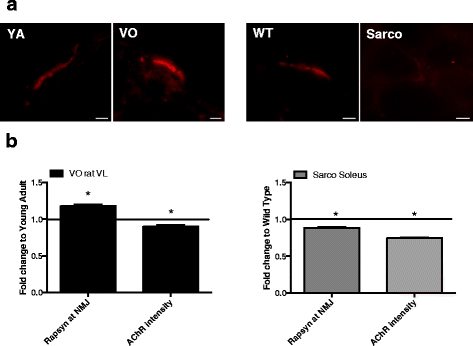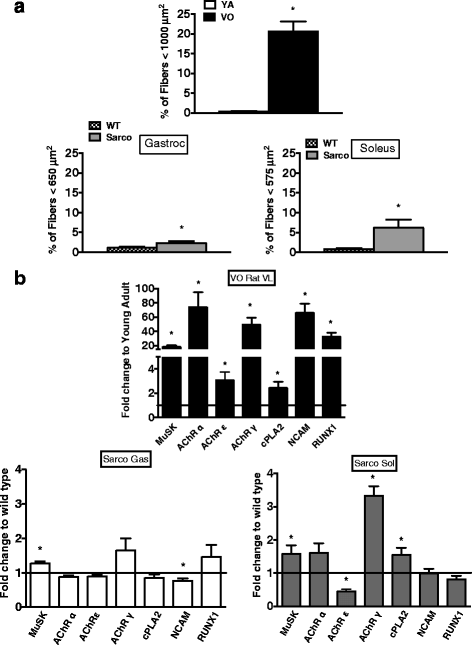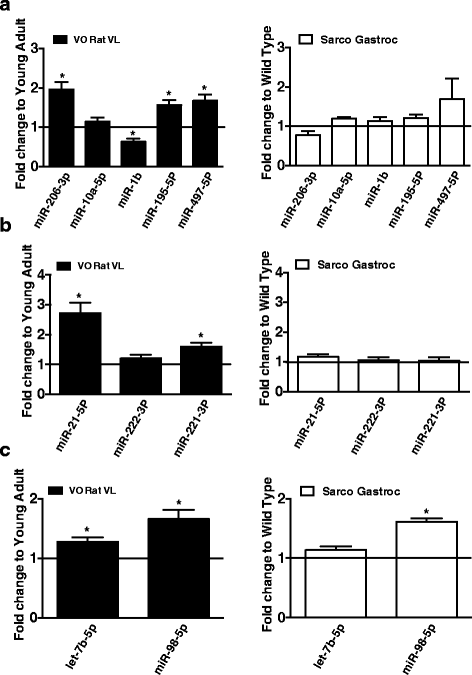Failed reinnervation in aging skeletal muscle
- PMID: 27588166
- PMCID: PMC5007704
- DOI: 10.1186/s13395-016-0101-y
Failed reinnervation in aging skeletal muscle
Abstract
Background: Skeletal muscle displays a marked accumulation of denervated myofibers at advanced age, which coincides with an acceleration of muscle atrophy.
Methods: In this study, we evaluated the hypothesis that the accumulation of denervated myofibers in advanced age is due to failed reinnervation by examining muscle from young adult (YA) and very old (VO) rats and from a murine model of sporadic denervation secondary to neurotrypsin over-expression (Sarco mouse).
Results: Both aging rat muscle and Sarco mouse muscle exhibited marked fiber-type grouping, consistent with repeating cycles of denervation and reinnervation, yet in VO muscle, rapsyn at the endplate increased and was associated with only a 10 % decline in acetylcholine receptor (AChR) intensity, whereas in Sarco mice, there was a decline in rapsyn and a 25 % decrease in AChR intensity. Transcripts of muscle-specific kinase (21-fold), acetylcholine receptor subunits α (68-fold), ε (threefold) and γ (47-fold), neural cell adhesion molecule (66-fold), and runt-related transcription factor 1 (33-fold) were upregulated in VO muscle of the rat, consistent with the marked persistent denervation evidenced by a large proportion of very small fibers (>20 %). In the Sarco mice, there were much smaller increases in denervation transcripts (0-3.5-fold) and accumulation of very small fibers (2-6 %) compared to the VO rat, suggesting a reduced capacity for reinnervation in aging muscle. Despite the marked persistent denervation in the VO rat muscle, transcripts of neurotrophins involved in promoting axonal sprouting following denervation exhibited no increase, and several miRNAs predicted to suppress neurotrophins were elevated in VO rat.
Conclusions: Our results support the hypothesis that the accumulation of denervated fibers with aging is due to failed reinnervation and that this may be affected by a limited neurotrophin response that mediates axonal sprouting following denervation.
Keywords: Aging; Denervation; MicroRNA; Muscle atrophy; Neurotrophins; Reinnervation; Sarcopenia; Skeletal muscle.
Figures





Similar articles
-
Voluntary resistance wheel exercise from mid-life prevents sarcopenia and increases markers of mitochondrial function and autophagy in muscles of old male and female C57BL/6J mice.Skelet Muscle. 2016 Dec 13;6(1):45. doi: 10.1186/s13395-016-0117-3. Skelet Muscle. 2016. PMID: 27964759 Free PMC article.
-
Fidelity of muscle fibre reinnervation modulates ageing muscle impact in elderly women.J Physiol. 2019 Oct;597(19):5009-5023. doi: 10.1113/JP278261. Epub 2019 Aug 21. J Physiol. 2019. PMID: 31368533
-
Denervation-related changes in acetylcholine receptor density and distribution in the rat flexor digitorum sublimis muscle.Ital J Anat Embryol. 2008 Oct-Dec;113(4):209-16. Ital J Anat Embryol. 2008. PMID: 19507461
-
Maintenance of neurite contacts at junctional regions of cultured individual muscle fibers from aged rats is correlated with the presence of a synapse-associated protein, gelasmin.Mech Ageing Dev. 1989 Aug;49(2):171-97. doi: 10.1016/0047-6374(89)90100-0. Mech Ageing Dev. 1989. PMID: 2677536 Review.
-
Skeletal muscle regeneration during aging and after long-term denervation.Tsitologiia. 1997;39(10):965-8. Tsitologiia. 1997. PMID: 9505343 Review.
Cited by
-
Chemogenetic inhibition of TrkB signalling reduces phrenic motor neuron survival and size.Mol Cell Neurosci. 2023 Jun;125:103847. doi: 10.1016/j.mcn.2023.103847. Epub 2023 Mar 21. Mol Cell Neurosci. 2023. PMID: 36958643 Free PMC article.
-
Higher expression of denervation-responsive genes is negatively associated with muscle volume and performance traits in the study of muscle, mobility, and aging (SOMMA).Aging Cell. 2024 Jun;23(6):e14115. doi: 10.1111/acel.14115. Epub 2024 Jun 3. Aging Cell. 2024. PMID: 38831622 Free PMC article.
-
Redox responses in skeletal muscle following denervation.Redox Biol. 2019 Sep;26:101294. doi: 10.1016/j.redox.2019.101294. Epub 2019 Aug 8. Redox Biol. 2019. PMID: 31450104 Free PMC article.
-
Human motor unit characteristics of the superior trapezius muscle with age-related comparisons.J Neurophysiol. 2019 Aug 1;122(2):823-832. doi: 10.1152/jn.00138.2019. Epub 2019 Jun 26. J Neurophysiol. 2019. PMID: 31242057 Free PMC article.
-
Aquaporin 4 Expression Level Is Decreased in Skeletal Muscles with Aging.Kobe J Med Sci. 2023 Jun 22;69(2):E40-E48. Kobe J Med Sci. 2023. PMID: 37357177 Free PMC article.
References
-
- Larsson L. Motor units: remodeling in aged animals. J Gerontol A Biol Sci Med Sci. 1995;50:91–95. - PubMed
-
- Rowan SL, Purves-Smith FM, Solbak NM, Hepple RT. Accumulation of severely atrophic myofibers marks the acceleration of sarcopenia in slow and fast twitch muscles. Exp Gerontol. 2011;46:660–669. - PubMed
Publication types
MeSH terms
Substances
Grants and funding
LinkOut - more resources
Full Text Sources
Other Literature Sources
Miscellaneous

